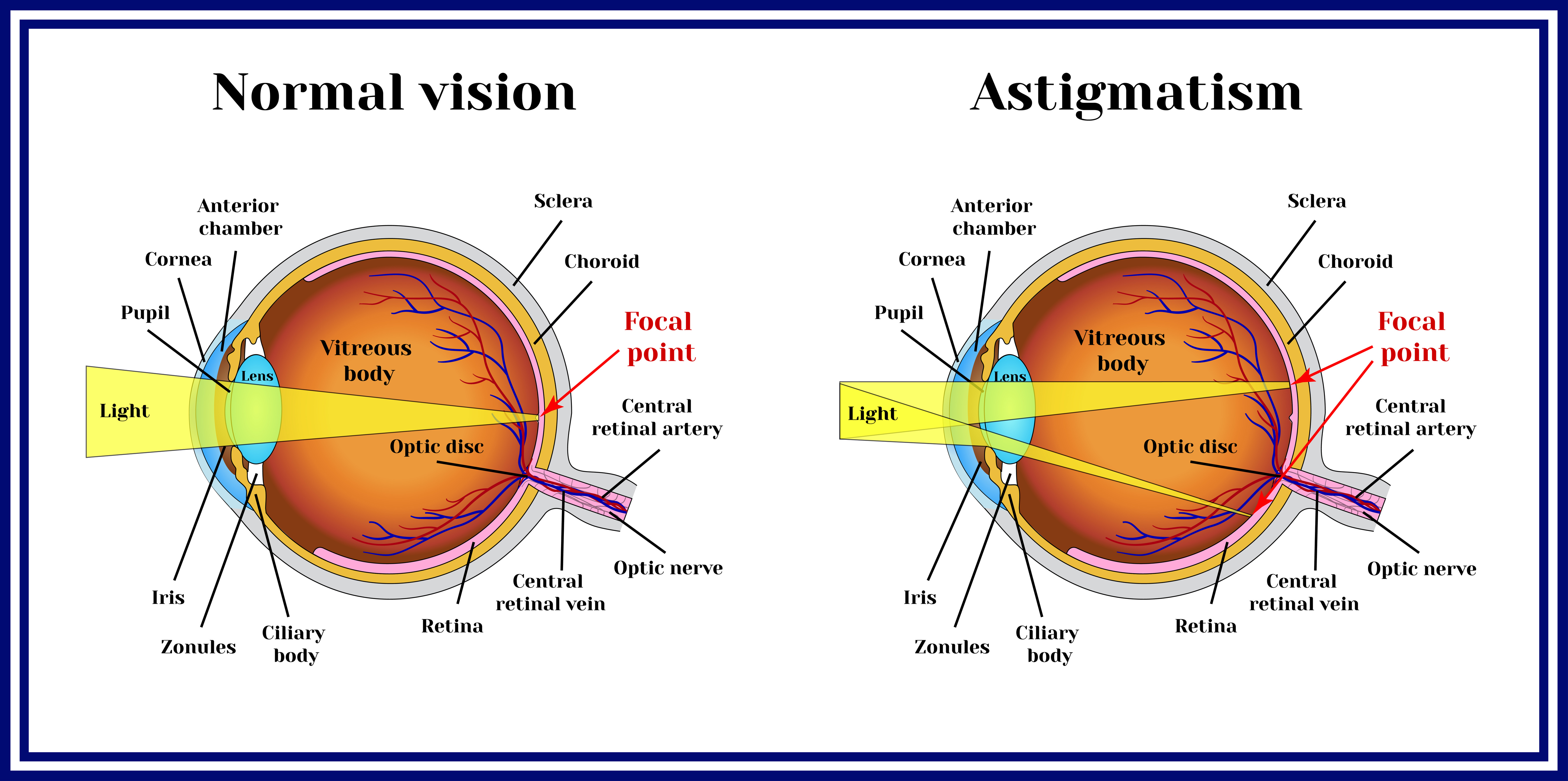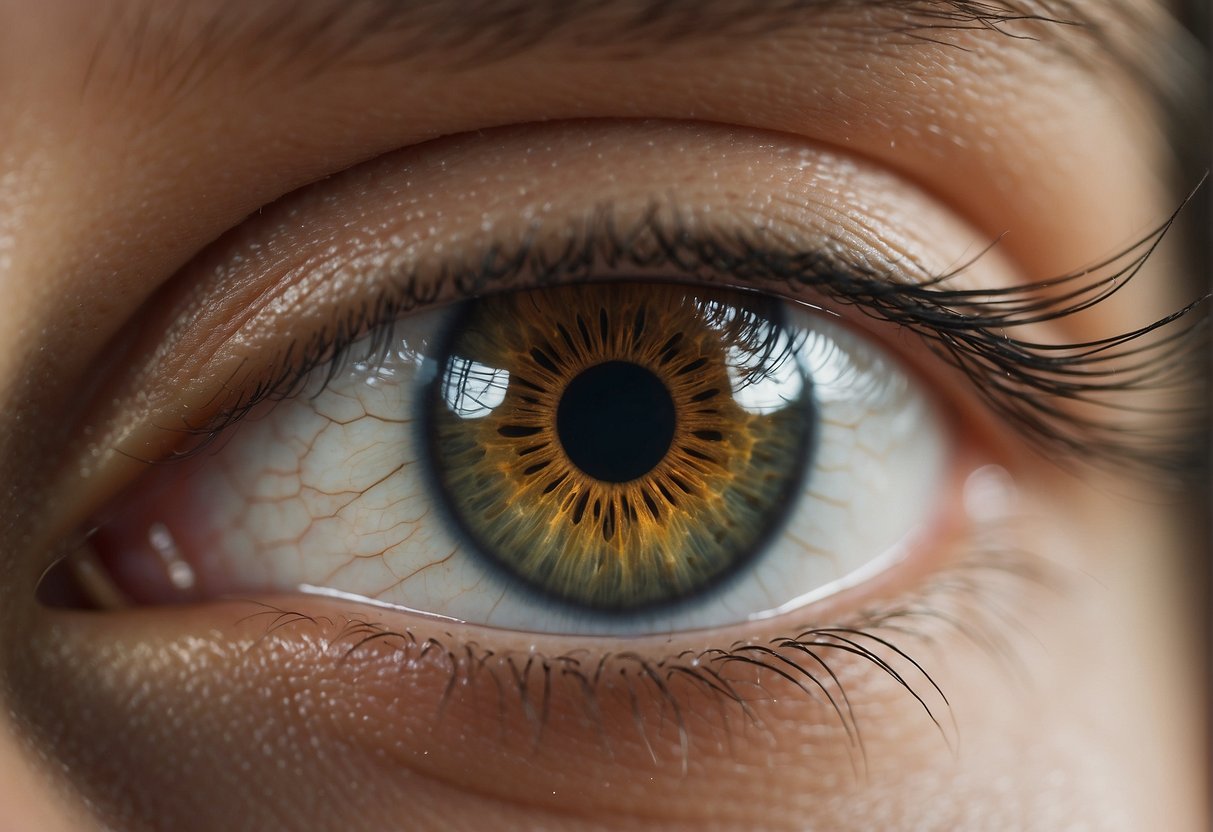
What Is Astigmatism: Understanding Eye Refraction Irregularities
Posted by Team Debby on 23rd Apr 2024
What Is Astigmatism: Understanding Eye Refraction Irregularities
Astigmatism is a common vision condition caused by an irregularly shaped cornea or lens. When the surface of the cornea or the lens inside the eye has a mismatched curve, light rays do not focus properly on the retina. This irregularity can lead to blurred vision at any distance, which is the hallmark of astigmatism.

A person with astigmatism will often experience distorted or fuzzy vision, especially when looking at fine details, either up close or from a distance. Diagnosing astigmatism typically involves a comprehensive eye examination. This may include tests to measure how the eyes focus light and to determine the prescription needed to correct vision.
Key Takeaways
- Astigmatism results from an irregularly curved cornea or lens, affecting how light is focused on the retina.
- Symptoms include blurred or distorted vision, requiring a comprehensive eye exam for diagnosis.
- Correction methods often involve glasses, contact lenses, or surgery to improve the focusing ability of the eye.
Understanding Astigmatism

Astigmatism is a common refractive error characterized by an irregular curvature of the eye's cornea or lens. This condition can lead to blurred or distorted vision at various distances. We will explore the nuances of astigmatism, including its types, causes, and risk factors.
Defining Astigmatism
Astigmatism occurs when the eye's cornea or lens is not perfectly curved, causing light rays to focus unevenly on the retina. This results in refractive error, where vision becomes blurred for both near and distant objects. Astigmatism can occur in combination with other refractive errors, such as myopia (nearsightedness) or hyperopia (farsightedness).
Types of Astigmatism
There are several types of astigmatism, each defined by where the irregularity occurs and the direction of the curvature:
- Regular Astigmatism: The most common form, where the cornea curves more in one direction than the other.
- Irregular Astigmatism: This type often arises from an eye injury or disease. It is characterized by a cornea that is not evenly curved in multiple directions.
- Myopic Astigmatism: One or both principal meridians of the eye are nearsighted.
- Hyperopic Astigmatism: One or both principal meridians are farsighted.
- Mixed Astigmatism: One principal meridian is nearsighted, while the other is farsighted.
Causes and Risk Factors
The precise cause of astigmatism is not entirely understood, but it often presents at birth and may change over time. Several factors can contribute to its development:
- Genetics: A family history of astigmatism or other eye disorders can increase the risk.
- Birth: Some research suggests that pressures on the head during birth may play a role in the development of corneal shape.
- Eye Injury: Damages to the cornea can lead to irregular astigmatism.
Astigmatism is not caused by reading in low light or sitting too close to the television. Regular eye examinations are essential for early detection and management of astigmatism to prevent complications.
Symptoms and Diagnosis

In this section, we’ll discuss the signs that may suggest someone has astigmatism and the methods medical professionals use to diagnose this vision condition.
Recognizing Symptoms
Astigmatism is predominantly characterized by an overall blur or distortion in vision. Symptoms that we are likely to notice include:
- Difficulty focusing on fine details, either up close or at a distance
- A need to squint regularly to see clearly
- Headaches and eyestrain after visual tasks
- Distorted vision, where straight lines appear wavy or bent
Astigmatism can occur alone or may be accompanied by other refractive errors such as nearsightedness or farsightedness.
Diagnostic Procedures
To diagnose astigmatism, eye care professionals rely on several methods to measure how the eyes focus light. An eye exam is the first step. The examination includes:
- Visual acuity assessment, where patients read letters on a chart to measure sight sharpness
- Keratometry, to measure the curvature of the cornea's surface
- Using a phoropter or an autorefractor to gauge how light bends as it enters the eye
A phoropter assesses the reaction of the eyes to different lenses, while an autorefractor automatically evaluates which lens prescription will yield the clearest vision. Using these tools helps us determine the presence and degree of astigmatism, leading to a more accurate diagnosis and optimal corrective lens prescription.
Corrective Measures

We understand that treating astigmatism effectively requires precision and personalization. The corrective measures available to us include non-invasive options like eyewear and more permanent solutions through surgery.
Eyewear Solutions
For many of us, eyeglasses and contact lenses are the first line of treatment for astigmatism. Glasses with toric lenses are crafted to counteract the irregular curvature of the cornea or lens in our eyes. Prescription strength varies based on the degree of astigmatism.
- Eyeglasses: These are often the simplest corrective measure. Made with toric or lenticular lenses, they can provide clear vision and are an accessible option for most people.
- Contact Lenses: Soft toric contact lenses or rigid gas permeable lenses may offer a clearer vision for some of us and are suitable for various degrees of astigmatism. Orthokeratology is a method involving specially designed contacts worn overnight to temporarily reshape the cornea.
Surgical Options
When eyewear isn't sufficient or desirable, various surgical options are available to treat astigmatism. These surgeries reshape the cornea to correct its irregular shape.
- LASIK: Short for Laser-Assisted In Situ Keratomileusis, this popular refractive surgery uses a laser to reshape the cornea, offering us a potential long-term solution for astigmatism.
- PRK: Photorefractive Keratectomy is another type of refractive surgery that removes a small amount of the cornea's surface to change its curvature.
- Cataract Surgery: For those of us with astigmatism and cataracts, this surgery can replace the clouded lens with an artificial one, often a toric lens, to correct the refractive error.
- Keratoconus Treatments: In cases of keratoconus, where the cornea becomes cone-shaped, we may opt for procedures like corneal cross-linking to strengthen corneal tissue and prevent further deterioration.
It's essential for us to consult with our eye care provider to determine which method aligns best with our specific needs and lifestyle.
Living with Astigmatism

Astigmatism affects our vision in various ways, and living with it requires an understanding of its impacts and the adoption of strategies for effectively managing our daily activities.
Daily Life and Management
In our daily life, managing astigmatism starts with the correct prescription for glasses or contact lenses. We must ensure that these corrective lenses are regularly updated to match changes in our vision. For children, it is crucial to monitor their vision closely because uncorrected astigmatism can lead to amblyopia, commonly known as lazy eye. Regular eye exams are essential to detect changes in our vision, be it from myopia (nearsightedness), hyperopia (farsightedness), or astigmatism.
Proper lighting can also lessen symptoms like blurry vision and eye strain. It's important to use adjustable lighting sources and reduce glare on screens to improve our night vision and reduce discomfort.
Here's a brief list for managing astigmatism on a day-to-day basis:
- Wear Corrective Lenses: Glasses or contact lenses should be up-to-date.
- Monitor Children's Vision: Special attention is required for younger family members.
- Adjust Lighting: Enhance visibility and reduce glare.
- Take Breaks: To prevent eye strain, rest your eyes periodically during tasks involving visual focus.
Monitoring and Ongoing Care
Ongoing care involves regular check-ups with an eye doctor such as an ophthalmologist or optometrist. These professionals use tools like the eye chart and corneal topography to assess the regularity and irregularity of the cornea's shape. It's especially important for us to keep these appointments, as astigmatism can change over time.
For those of us experiencing cataract symptoms, the impact of astigmatism on our vision may change following cataract surgery, thus necessitating a new vision correction plan. If we have concerns about our vision or are experiencing new symptoms like increased blurry vision or difficulties with night activities, it’s important to contact our eye doctor.
Here’s a simple care checklist:
- Regular Eye Exams: Essential for detecting any changes in vision or lens prescriptions.
- Communicate Changes: Inform your eye doctor of any new visual symptoms.
- Follow Doctor’s Advice: Use prescribed corrective lenses and follow any additional recommendations.
- Cataract Consideration: Post-surgery, our vision may need reassessment.
Advancements in Treatment

We have witnessed notable progress in the domain of astigmatism treatment, stemming from both innovative surgical methods and the development of more efficient corrective lenses.
Innovative Surgical Techniques
LASIK Surgery: We now benefit from advanced forms of LASIK surgery, a prevalent option for correcting astigmatism. Modern LASIK leverages wavefront technology to create a precise map of the eye. This allows for more accurate and individualized reshaping of the cornea. These advances have made the procedure safer and increased the likelihood of achieving 20/20 vision or better.
PhotoRefractive Keratectomy (PRK): Improved techniques in PRK have also been instrumental in treating astigmatism. This form of eye surgery involves the removal of a minimal amount of the cornea's surface layer, followed by reshaping with a laser. Our enhanced understanding of corneal healing and refined surgical methods has reduced PRK recovery times and enhanced outcomes.
Developments in Corrective Lenses
Gas Permeable and Soft Lenses: We are creating new types of gas permeable lenses that provide sharper vision for those with astigmatism. These lenses are rigid yet allow oxygen to pass through, increasing comfort. Advancements in soft lens materials have led to soft toric lenses with various prescription options that cater to different degrees of astigmatism.
Table of Lens Features:
| Type | Benefits |
|---|---|
| Gas Permeable | Enhances vision clarity |
| Higher oxygen permeability | |
| Soft Toric Lenses | Versatile prescription availability |
| Comfortable for longer wear |
Our exploration into improving these lenses means a higher degree of customization and better management of refractive errors for our patients. This personalization ensures that individuals with astigmatism can select the option that best fits their lifestyle and vision needs.
Frequently Asked Questions

In this section, we provide answers to common questions regarding astigmatism, addressing its correction, symptoms, diagnosis, treatments, progression, and genetic factors.
How can astigmatism be corrected?
For correcting astigmatism, we typically use prescription eyeglasses or contact lenses tailored to counteract the irregular curvature of the cornea. In some cases, refractive surgery such as LASIK may also be an option.
What are the common symptoms of astigmatism?
Common symptoms include blurred or distorted vision at all distances, difficulty seeing at night, eyestrain, and headaches. If you experience these, we recommend an eye exam.
How can astigmatism be diagnosed?
A comprehensive eye exam is used to diagnose astigmatism. This includes testing for visual acuity and a refraction assessment. A keratometer or corneal topography may also be used to measure the curvature of the cornea.
What treatments are available for astigmatism?
The treatments for astigmatism include corrective lenses, such as toric contact lenses or eyeglasses, and refractive surgery. The choice of treatment depends on the severity of the astigmatism and the individual’s needs.
Can astigmatism worsen over time, and what causes it to do so?
Astigmatism can sometimes worsen over time due to factors like age, continued eye stress, or an underlying condition known as keratoconus. Regular eye exams can help monitor changes in vision and astigmatism.
Is there a genetic component to astigmatism?
Yes, astigmatism often runs in families. However, its development can also be influenced by environmental factors and health conditions.

